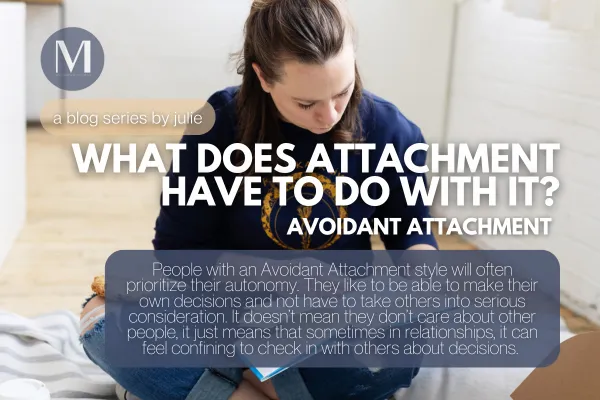the blog
A place for our team to share about topics they are passionate about, in hopes of allowing you to see and understand a bit more behind the faces on these pages.

What Does Attachment Have To Do With It? Avoidant Attachment
Let’s dive into Avoidant Attachment.
This often looks like someone who is highly independent and self-reliant. They might want to be close to others and be emotionally attached but when it feels like they get too close, they push the other person away or withdraw themselves. The person with an Avoidant Attachment style will often prioritize their autonomy. They like to be able to make their own decisions and not have to take others into serious consideration. It doesn’t mean that they don’t care about other people, it just means that sometimes in relationships, it can feel confining to check in with others about decisions.
I want you to imagine that friend or partner you have that appears to be doing their own thing all the time. They might work a lot, go on adventures, travel by themselves, or they may pick more solo sports/activities to do. When you ask them how they REALLY are, they say they’re good or fine but when you try to dig deeper, they either can’t or won’t go there. They’ll likely stick to topics that feel emotionally safe for them. When something really is wrong, they might withdraw. You may try to reach out and connect with them to check in, but they don’t respond right away or for quite a while. They reappear again when things have stabilized for them and you may not even know that something is wrong until they tell you about it. They will likely try to show that everything is fine now. These are some of the ways that Avoidant Attachment can show up in relationships.
The person with an Avoidant Attachment style still wants connection, but one that’s behind a wall of self-preservation; due to the feeling of connections with people not feeling safe. No matter how much you may tell them it’s safe, they have to see it consistently over time (usually a long time) before they start to truly believe it. There is still a fear of rejection; however, instead of like the Anxious Attachment style where there is a seeking of reassurance, the Avoidant Attachment will withdraw and put the walls up before someone else may reject them. When a person gets to the point of letting their walls down and deeply connecting with someone else, and there is a breakdown in that relationship, it can be completely devastating to the individual with Avoidant Attachment. In response, they will often throw themselves into an activity such as work, school or other activities to help cope with the pain of the relational breakdown. They often won’t reach out to others because that one relational breakdown reconfirmed their internal belief that connection isn’t safe and that it’s “easier” to do it on their own.
Avoidant Attachment often develops in the early years (0-5 yrs) due to their caregiver not being available to meet the child’s needs, mentally, emotionally and/or physically. This teaches the child that they need to fend for themselves and figure it out on their own - that other people are not dependable. These kids often become very self-reliant and independent and each relationship that doesn’t work, confirms the belief that they’re on their own. Being isolated and on your own as a human is inherently traumatic as we are biologically wired for connection.
At the core, people with Avoidant Attachment want deep connection, but it doesn’t feel safe to have that. The best way to develop that is through consistent, reliable relationships over a long period of time. If you’re wanting to explore your attachment style and how it’s impacted and impacting your life, feel free to connect with us, we’d love to chat with you.
Office Location: 1200 Brock Street South, Whitby, ON. L1N 4L9
© Marquis Counselling & Consulting | ALL RIGHTS RESERVED | TERMS & CONDITIONS | PRIVACY POLICY

